Yosemite National Park is a regular contender for the title of best National Park in the United States. It is located in California and offers breathtaking views, unique rock formations, lakes, mountains, wildlife and every possible type of outdoor activity. There are so many things to do in Yosemite National Park that most people who live close enough visit multiple times a year, as it’s hard to squeeze everything into one trip. Depending on the season, the park also offers different activities, such as the epic firefall in February, skiing in December and swimming, kayaking and camping over the warmer months.
The park is a hiker’s dream, with various trails for all ages and skill sets, most ending in jaw-dropping views over the park’s iconic Half Dome, El Capitan or one of the multiple waterfalls. It’s worth spending at least a long weekend, if not longer, in the park. You can stay in nearby Mariposa or El Portal or in Yosemite Valley, which has a couple of extremely popular hotels and several campgrounds, plus a shop, cafes and visitor’s centre.
Contents
- Yosemite National Park, California
- Top Tours
- 20 Things To Do In Yosemite National Park
- 1- Stop At The Tunnel View Lookout Point
- 2- Admire The Redwoods At Mariposa Grove
- 3- Hike Half Dome
- 4- Enjoy The Reflections In Mirror Lake
- 5- Hike Yosemite Falls
- 6- Spot The Rock Climbers On El Capitan
- 7- Feel The Power Of Bridalveil Fall
- 8- Admire Cathedral Peak
- 9- Go Hiking On Mist Trail
- 10- Taft Point & Sentinel Dome
- 11- Take A Photo At Glacier Point
- 12- Drive The Tioga Pass
- 13- Cross-Country Ski To Tenaya Lake
- 14- Enjoy The Wildflowers At Tuolumne Meadows
- 15- Go Hiking In Hetch Hetchy Valley
- 16- Sleep Or Dine At The Ahwahnee
- 17- Say ‘I Do’ At Yosemite Valley Chapel
- 18- Go Wildlife Spotting
- 19- Go Camping Under The Stars
- 20- Go Skiing At Badger Pass Ski Area
Yosemite National Park, California
20 Things To Do In Yosemite National Park
1- Stop At The Tunnel View Lookout Point
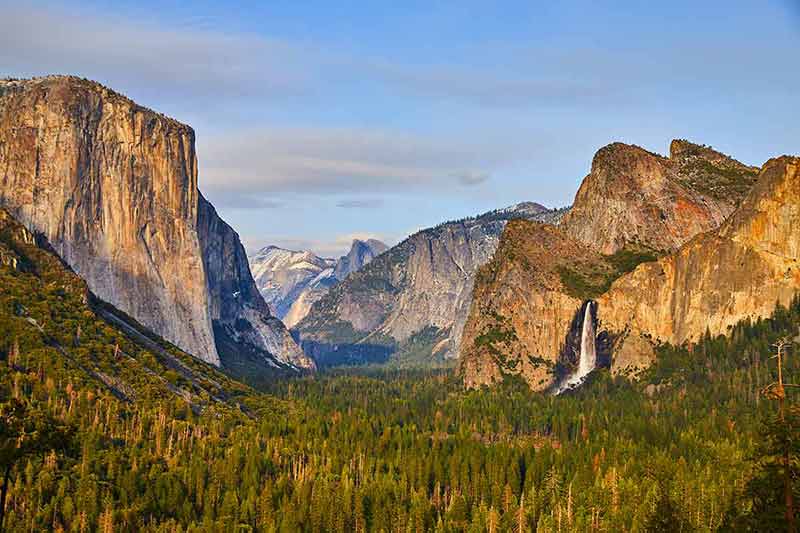
Most people visiting Yosemite will enter from the West, where Tunnel View will be your first introduction to the breathtaking scenery in Yosemite.
Located inside the park after you have presented your permit and paid the entrance fee, the viewpoint is past the Wawona Tunnel.
There is a small car park and a lookout point.
From Tunnel View, you can see some of Yosemite’s most famous sights, including Half Dome, El Capitan and Bridalveil Fall, and the endless carpet of trees on the valley floor below.
This is one of the few viewpoints in the park that can be reached by car, although it is also the most famous, so the later you arrive, the more likely it is that the car park here will be full.
2- Admire The Redwoods At Mariposa Grove
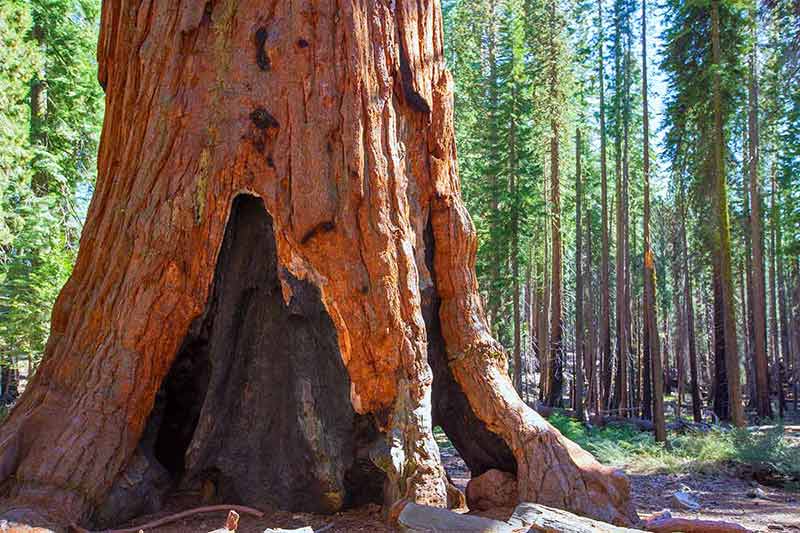
If you haven’t explored California’s Sequoia National Park, you can find some of the state’s oldest and most fascinating giant redwoods in Yosemite.
The Giant Sequoias Trail is the most popular hike here, and make it as short or long as you like.
It passes some of the most famous trees, such as The Faithful Couple, Clothespin Tree, Wawona Tree Tunnel and Grizzly Giant, which is the largest in the park and estimated to be more than 2,700 years old.
The grove lies slightly south within the park, so you’ll need to make a slight detour out by car since the Yosemite shuttle doesn’t go this far. If you’re visiting from San Francisco, check out this tour.
3- Hike Half Dome
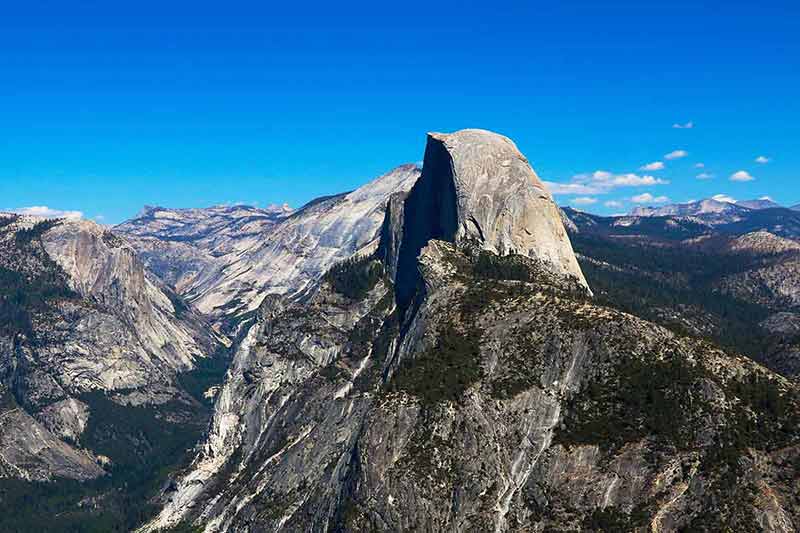
Half Dome is possibly the most iconic sight in Yosemite and can’t be missed – literally, because you can see it from so many places.
This unique towering granite rock formation stands tall above the valley, and you can hike to the top, although it is one of the park’s longer and more strenuous trails, plus you will need special permits for the hike or join a hiking tour with a professional guide.
The Cables at the top of the hike are known for being tricky and sometimes dangerous, as they are a series of barely-there chains you’ll need to use to pull yourself up the nearly vertical rock face.
However, many people hike up Half Dome and stop just before the cables for an equally fantastic view.
There are plenty of other places you can spot it, such as from Tunnel View or Glacier Point.
4- Enjoy The Reflections In Mirror Lake
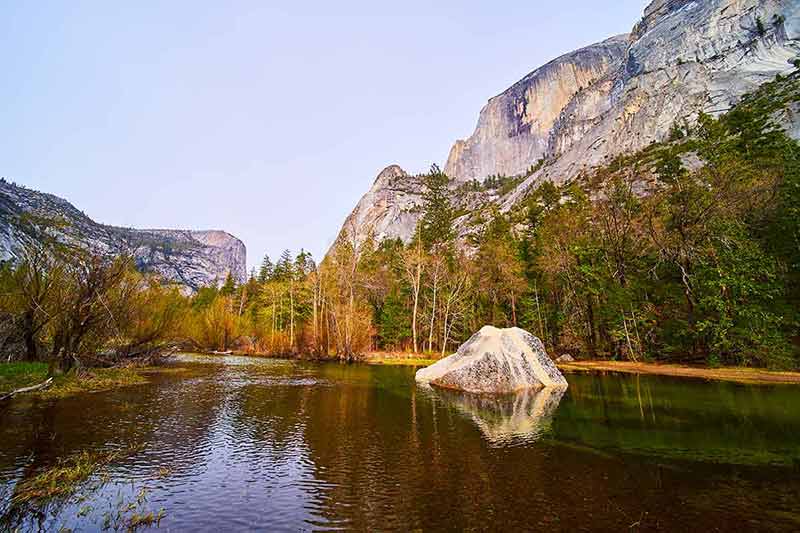
Mirror Lake is an easy and scenic spot with one of Yosemite’s most picture-perfect views.
Located very close to Yosemite Valley, you can reach it on foot or by car.
Try and head here on a clear, still day for the best photos.
The lake has a beautiful backdrop of Half Dome and El Capitan and the stunning trees and groves, providing a perfect reflection when the lake is still.
In summer, it is a popular spot for a dip to cool off after a hike, and it is also home to some of the park’s wildlife, such as rabbits, deer and, more rarely, bears.
5- Hike Yosemite Falls
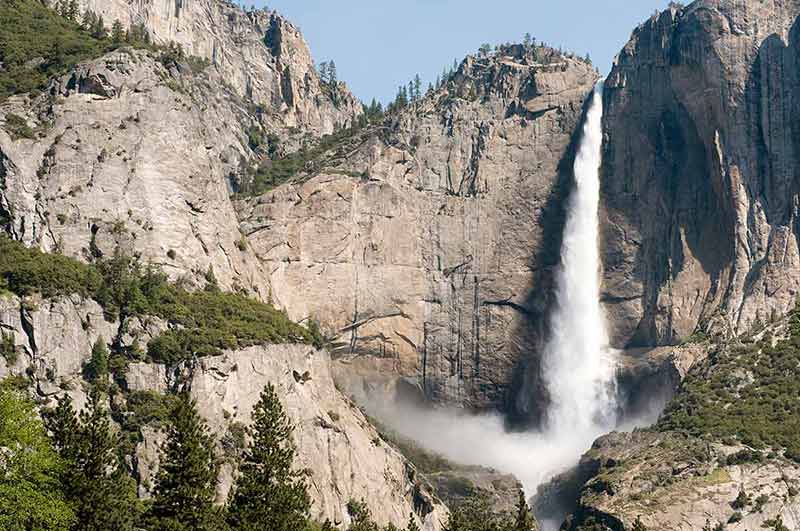
Yosemite Falls is one of two famous falls in the park and is the highest waterfall in the United States.
It is divided into sections, so you can choose an easier trail to visit Lower Yosemite Falls or a more strenuous hike to Upper Yosemite Falls.
If you’re in a rush, the falls can also be seen from multiple viewpoints in the park.
The best time to visit the falls is from May to June in late spring, when the winter snow has melted into the rivers, causing the falls to have their strongest flow.
Avoid visiting in the height of summer, when the falls often dry up. Check out this 3-day camping adventure.
For more California ideas, see:
- 40 Things To Do In Lake Tahoe
- 20 Things To Do In San Francisco At Night
- 21 Things To Do In Los Angeles At Night
- 23 Landmarks In Los Angeles
- 20 Landmarks In California
- 20 San Diego Landmarks
- 20 Songs About California
- Best Places To Visit in California
- 20 Things To Do In Santa Ana
- 20 Things To Do In Malibu
- Deserts In California Guide
- 20 Things To Do In Fremont
- 20 Things To Do In Berkeley
- 20 Things To Do In Monterey
- 20 Things To Do In Anaheim
- 20 Things To Do In Santa Rosa
- Best Time To Visit California
- Los Angeles To San Francisco Road Trip
- San Diego To San Francisco Road Trip
- 20 Things To Do In Ventura
- 20 Things To Do In San Luis Obispo
- 20 Things To Do In Palm Desert
- 20 Things To Do In Palm Springs
- 20 Things To Do In Pasadena
- Where To Stay In Los Angeles
- 20 Things To Do In Bishop CA
- San Francisco to Yosemite National Park Road Trip
- 20 Things To Do In Yosemite
- 20 Waterfalls In California
- 20 Things To Do In Big Bear
- 20 Things To Do In Laguna Beach
- 20 Things To Do In Solvang
- 20 Things To Do In San Ramon
- 20 Things To Do In Roseville
- 20 Things To Do In Carmel
- 15 Things San Francisco Is Famous For
- 20 Ghost Towns In California
- 20 Ways To Spend Christmas In California
- San Francisco Itinerary
- San Francisco Bike Tours
- San Francisco Go Cars
- Exploring Hearst Castle
- Yosemite National Park
- 9 California National Parks
- Lake Tahoe Snowshoe Adventure
- 20 Things To Do In Bakersfield
- 20 Things To Do In Redding California
- 20 Things To Do In Manhattan Beach
- 20 Things To Do In Fresno
- 20 Things To Do In Riverside
- 20 Things To Do In Long Beach
- 20 Places To Go Glamping In California
- 20 Things To Do In Eureka
- 20 Los Angeles Day Trips
- 20 San Francisco Day Trips
- 20 Things To Do In Santa Cruz
- 20 Things To Do In Beverly Hills
- 20 West Hollywood Bars
- 20 Things To Do In Half Moon Bay
- 20 Things To Do In Morro Bay
- 20 Beaches In San Francisco
- Grand Canyon National Park Photos
- 20 Things To Do In Stockton
- 20 Things To Do In Temecula
- 20 Things To Do In San Bernardino
- 20 California Cities
- 20 Things To Do In Irvine
- 20 Lake Tahoe Beaches
- 20 Things To Do In Yosemite in Winter
- 20 Things To Do In Lake Arrowhead
- 15 Things California Is Famous For
6- Spot The Rock Climbers On El Capitan
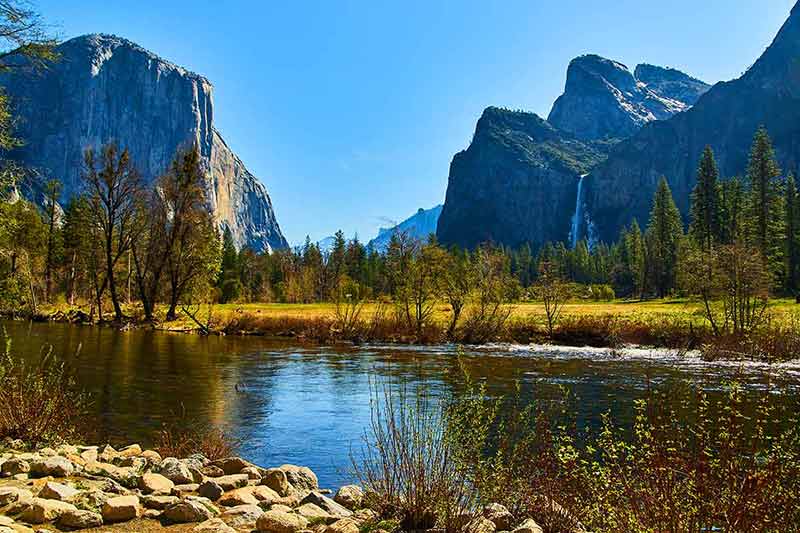
El Capitan is famous for being one of the most epic and challenging rockfaces for professional climbers worldwide, who visit in droves to try their hand at scaling it.
El Capitan is around 3,500 feet (1067 m) high, and a fun activity is simply seeing if you can spot the tiny climbers swinging from it.
Unless you are a skilled professional, it’s unlikely you’ll want to attempt the multiday climb, which requires complex permits, but there are alternative ways to see it.
Not only can El Capitan be seen from around Yosemite Valley, but you can also do the El Capitan hike.
It takes around eight to 10 hours, so it isn’t for beginners, but the view at the end is more than worth it.
7- Feel The Power Of Bridalveil Fall
The second of Yosemite’s most famous waterfalls, Bridalveil Fall, is also best seen in late spring when the falls are crashing down at full flow from the top of the 620 ft (189m) rock face, although it is technically open year-round.
It can be seen from various points in the park, and you can reach the base via a short hike – just 0.5 miles.
If you’re there is spring, expect to get hit by the spray when you reach the end.
For higher views, drive to the Bridalveil Fall viewpoint, or hike up to the top, although this can get dangerously slippery, so make sure you have the correct footwear.
8- Admire Cathedral Peak
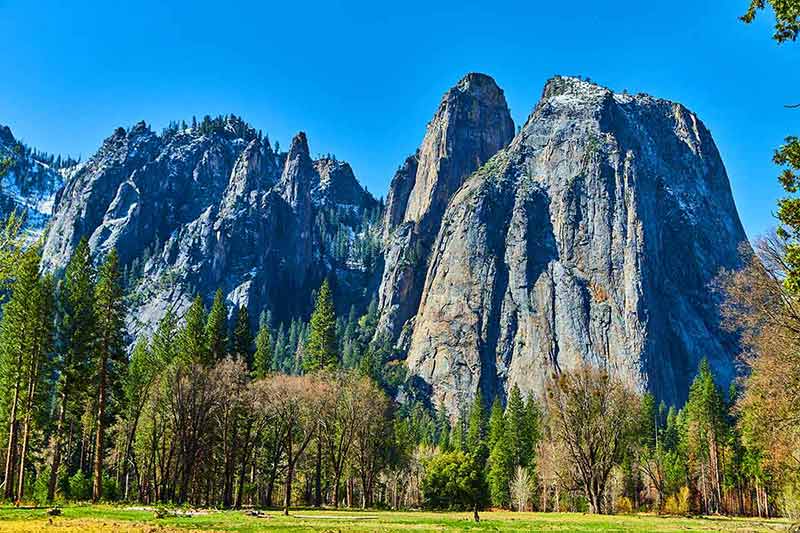
Some distance away to the east of the park, not far from the Tuolumne Meadows, Cathedral Peak is one of the most unique rock formations you can visit.
The peak is a granite structure that stems from the Eastern Sierra mountain range.
Most people admire the peak from a distance, at the nearby lake, which offers beautiful reflections during the day.
You can reach the top if you’re an experienced climber, although it is tricky and mainly for professionals.
The peak was named as it supposedly looks like a cathedral and was first summitted by famous mountaineer and guide John Muir, after whom the John Muir Trail in the park is named. Here’s a tour you may like.
9- Go Hiking On Mist Trail
The Mist Trail is one of the best hikes in Yosemite, leading to the stunning Nevada Falls and Vernal Falls.
You don’t have to be an expert hiker for this trail, but you should be relatively fit and mobile since you’ll be climbing a set of granite steps that wind their way up to the top of the falls.
It is around 2.5 miles (4 km) to the top of Vernal Falls, which takes around three hours, while Nevada Falls takes a much longer six hours.
This doesn’t include stopping on the way for photos, however, including a rest stop just before Vernal Falls, from where you can see the Three Brothers and Half Dome, plus sweeping views over the valley below.
10- Taft Point & Sentinel Dome
Taft Point is the best and yet most dangerous viewpoint in Yosemite National Park.
Taft Point is a high cliff with a sheer drop of almost 2000 ft (609 m) in some places to the valley below.
The views over the park are almost endless, and it is a popular spot for photographs, however, there have been tragic accidents here, so extreme caution is advised.
You can reach Taft Point via a 2.2-mile (3.5 km) roundtrip hike, beginning at the shuttle stop of the same name on Glacier Point Road.
As of 2022, the road closed due to rockfall and renovations, so the point can’t be accessed, but it is expected to reopen soon.
11- Take A Photo At Glacier Point
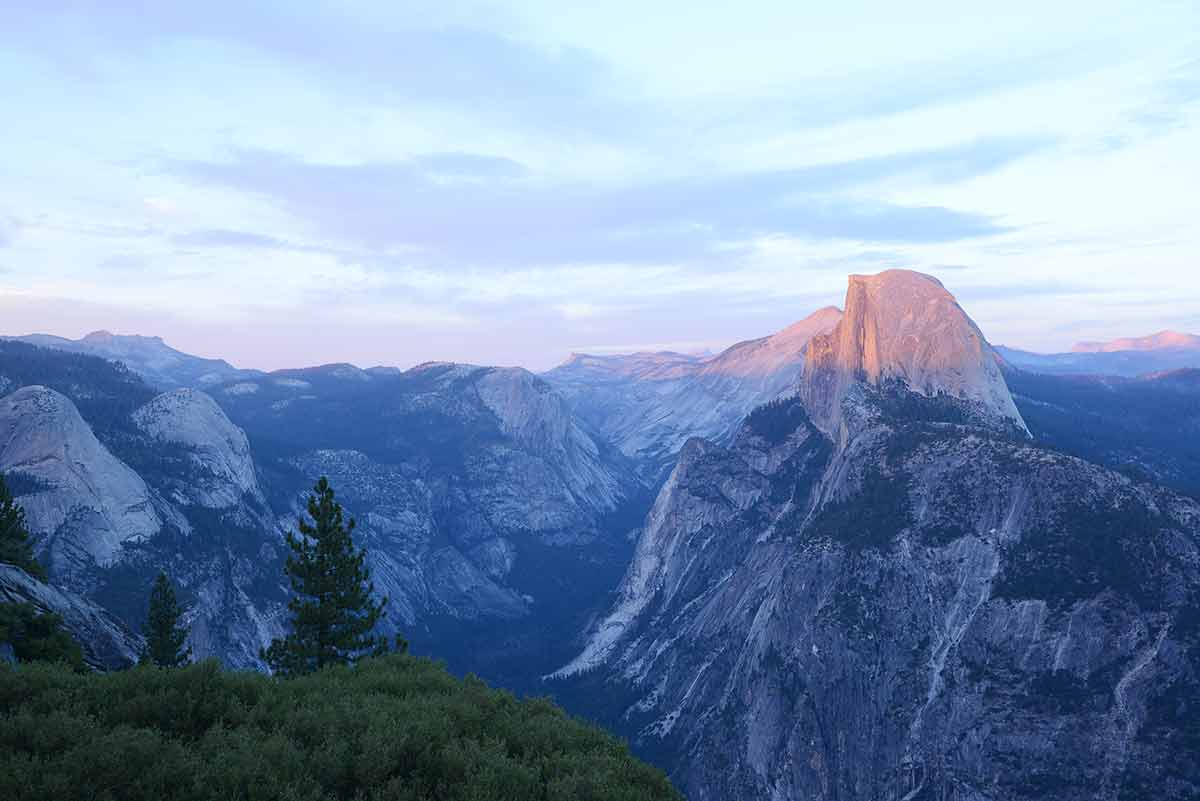
Glacier Point is another viewpoint that can’t be missed in Yosemite and if you had to pick one, this should be it.
Glacier Point stands at over 7000ft (2133 m), so you can see across the park, including over El Capitan, Half Dome, Yosemite Falls and the valley.
You can reach Glacier Point by car, meaning you don’t need any strenuous hikes to get here.
Unfortunately, in 2022, Glacier Point Road is closed, but it is still possible to reach this viewpoint via a four-hour hiking trail if you have the time to spare.
12- Drive The Tioga Pass
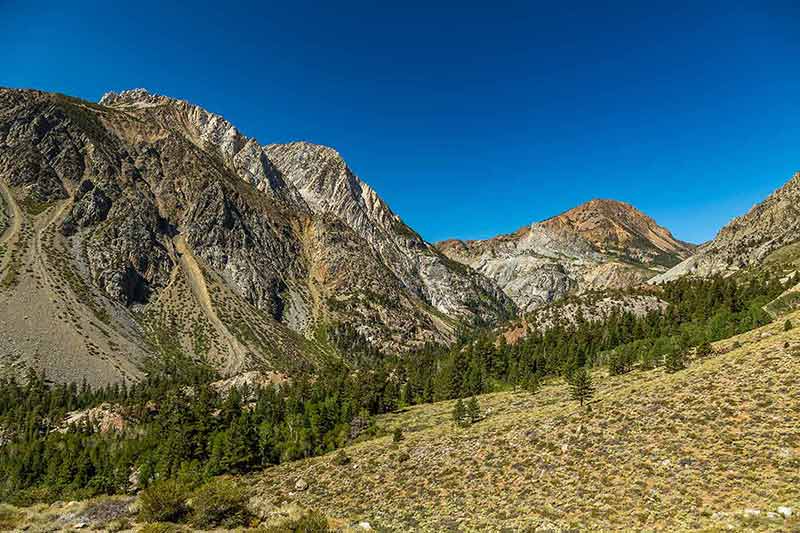
The Tioga Pass isn’t just one sight but an entire road leading east out of Yosemite.
It is the highest road in the park, reaching over 10,000 ft (3048 m) at some points, meaning as you drive, there are incredible views back over the valley and plenty of places to pull in for photos too.
Along the way, you’ll also pass dense forests, see views of the Eastern Sierras, Olmsted Point, pass Tenaya Lake, Cathedral Peak and the Tuolumne Meadows.
Surprisingly, the road is often missed out by visitors who do a valley loop before heading back west.
If you have time – the road takes three to four hours to drive, or much longer if you want to spend time at the attractions on the way, it is a must-do.
Another reason for the lack of people is that the pass is only open between May and October, while the rest of the year it is closed due to snowfall.
13- Cross-Country Ski To Tenaya Lake
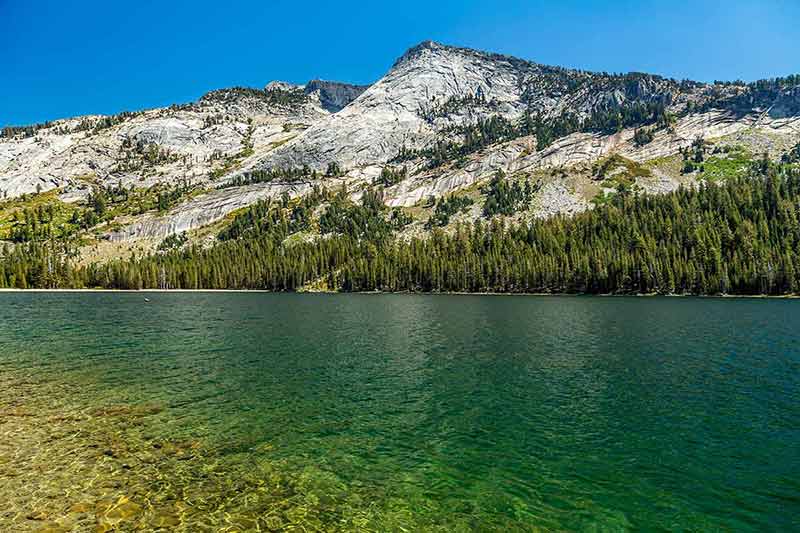
If you drive the Tioga Pass, you’ll pass Tenaya Lake on the way, so it’s worth stopping to explore.
It has scenic views in the distance and across the dense forests opposite, and you can stroll along the lake’s edge, a mix of smooth rocks and sand.
The lake has its own trail, which is around 3.4 miles roundtrip, however, the lake stands at 8,000 ft elevation, so you may feel more breathless than expected even if you’re fit.
In the summer, the water is popular for swimming and kayaking, and occasionally, you can skate in the winter.
While the pass remains closed, the lake is hard to reach in winter unless you’re a cross-country skier. If you’re looking for a winter adventure, this private Yosemite Valley tour is a good way to visit.
14- Enjoy The Wildflowers At Tuolumne Meadows
Tuolumne Meadows is one of the prettiest and most peaceful places in Yosemite, sitting between towering peaks and the Tuolumne River.
The soft green fields are often filled with wildflowers in the summer, and you’ll spot many deer grazing here too.
You can enjoy the views over the meadows, as well as Cathedral Peak, Lembert Dome and Pothole Dome, from the comfort of your car or head out on a hike such as the one to Soda Springs or the much longer 11-mile (17.7 km) Glen Aul trail.
The meadows sit at 8,600 feet (2621 m), so hikes may feel more strenuous, but there is plenty of waterfalls, creeks and forests to explore.
15- Go Hiking In Hetch Hetchy Valley
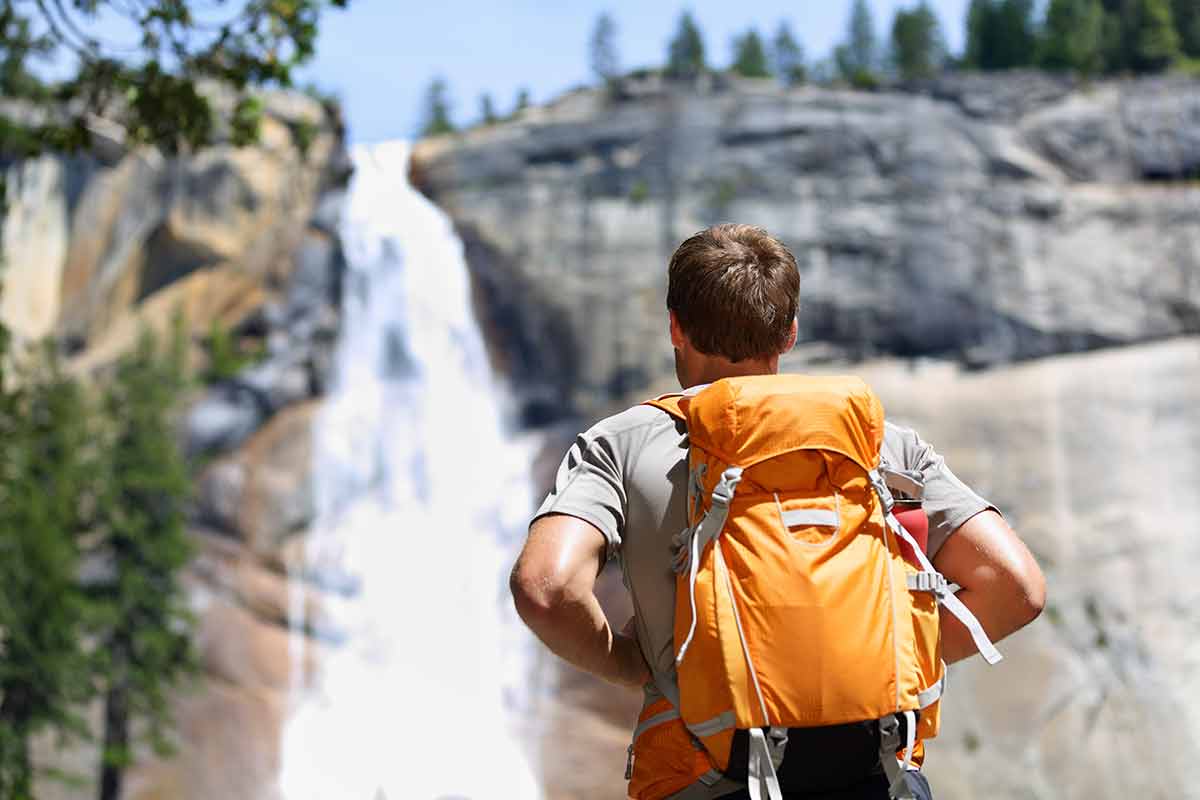
The Hetch Hetchy Valley is far less visited due to being in a remote northwest corner of Yosemite.
You’ll find the same stunning granite cliffs, waterfalls and lakes but with half the crowds if you make it here.
The main attraction is an eight-mile-long reservoir running through the valley, which is used to supply water to San Francisco.
There are plenty of hikes to explore the area, such as the Beehive Meadow Trail, the walk to Wapama Falls, or a route past the reservoir and huge O’Shaughnessy Dam.
To get here, you’ll need to drive quite a way – the valley is within Yosemite but its entrance is not, being close to the small town of Buck Meadows.
16- Sleep Or Dine At The Ahwahnee
There are several accommodation options available if you stay within the park, the Ahwahnee is undoubtedly the most popular and gets booked up a year in advance.
The stunning stone building, built in the 1920s, is designed to blend in with its surroundings and is registered on the list of National Historic Buildings.
Almost every famous person has dined here, from celebrities to US Presidents.
If you aren’t lucky enough to bag a stay here, you can still go for the food or join this semi-private tour that includes lunch there.
Their formal dining room is open for three meals a day, although men will be expected to wear suits and women a dress at dinner – so don’t forget to pack good clothes besides your hiking gear.
17- Say ‘I Do’ At Yosemite Valley Chapel
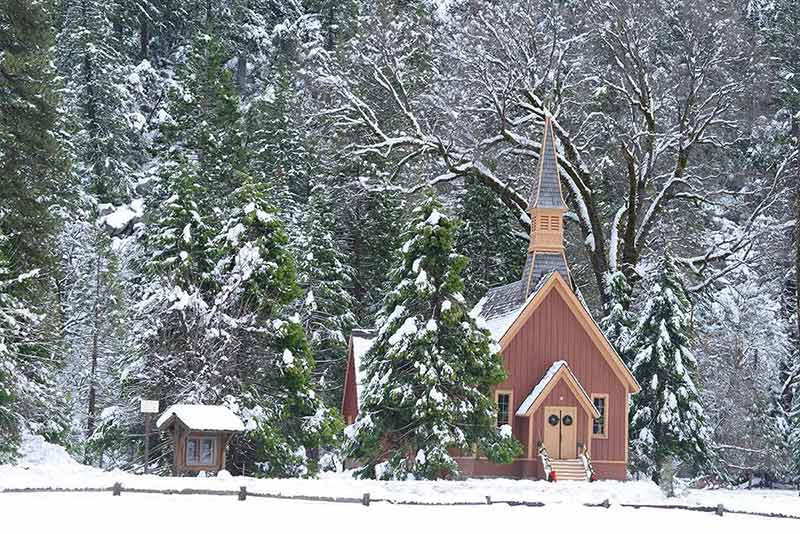
It is often a surprise to people that a church is Yosemite, and it’s one of the most beautiful spots to visit.
The elegant church with a stunning spire stands alone under a few trees at the base of Half Dome.
After looking inside, the main draw is the beautiful photos you can get, particularly in winter when it has a fairy tale dusting of snow.
Despite the church being a protected historic building, you can get married here, although you may have to book a few years ahead as it is an extremely popular place to say ‘I Do’.
18- Go Wildlife Spotting
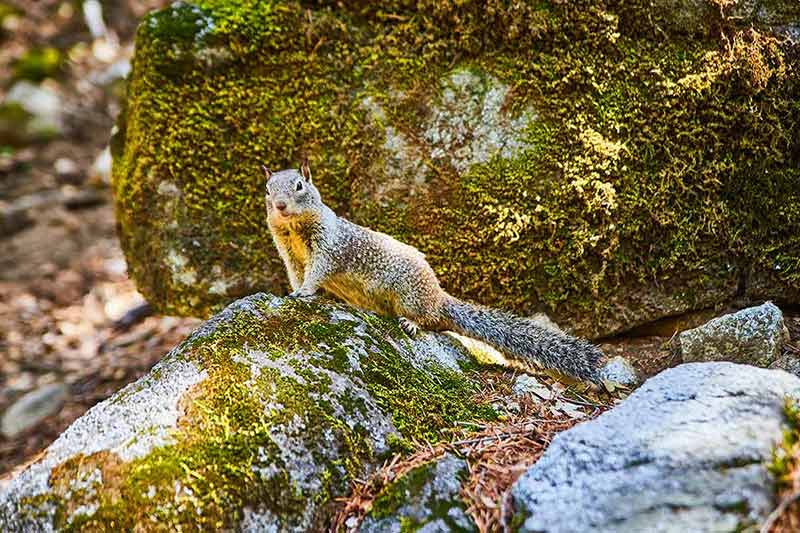
Even if you weren’t planning to seek out wildlife in Yosemite, you’ll see a huge variety wandering around the valley.
The local deer are frequently seen in Yosemite Village, at Mirror Lake and Tuolumne Meadows, while Bighorn Sheep can often be spotted on craggy cliffs and hiking trails.
Coyotes and bobcats are slightly rarer but still make appearances, so stay clear if you spot one.
Bird life, such as bright blue jays and rodents, like red squirrels, will also follow you as you walk.
The biggest animal in the park are the bears; spotting one is pure chance, although if you do, you should stay far away.
The park has bearproof bins, and you should never leave food out or visible in your vehicle.
A larger issue is for the bears, with up to 10 being hit and killed by cars driving through the park each year, so make sure to keep an eye out on the road.
19- Go Camping Under The Stars
Camping is a must try to get a feel for Yosemite National Park.
Whether you’re an avid camping lover, have never camped before, or are choosing to stay in your own slightly comfier RV, the park has multiple places to set up for a night outdoors.
The village has a shop selling supplies, and campgrounds are often packed, meaning there’s always someone on hand to help, and you might make a friend or meet someone doing the same hike.
Come prepared with good quality camping equipment, sustenance and warm clothing, and try to get a campground spot at least a few months in advance – six for more popular areas.
20- Go Skiing At Badger Pass Ski Area
Many visitors are so focused on seeing the most famous sights in Yosemite that they don’t realise the park has a small but exceedingly fun and well-equipped winter sports area.
The Badger Pass Ski resort is one of only three ski resorts in US National Parks with ski lifts.
The area has miles of trails for cross-country skiers, runs for different experience levels, a snowboard park and a tubing area perfect for kids and families.
You can also go snowshoeing or take a cross-country ski trip to the stunning Glacier Point.
All-day lift passes start at around $62, and you can rent skis, snowboards, boots and helmets, but remember to bring suitable ski clothing.
If you love exploring national parks, you might like to read:
- Wyoming National Parks Guide
- Nevada National Parks Guide
- Michigan National Parks Guide
- 5 Maine National Parks
- New Hampshire National Parks Guide
- 25 National Parks in Canada
- 17 National Parks in Argentina
- Tasmania National Parks
- 20 National Parks in Mexico
- 18 New Mexico National Parks
- 18 National Parks in Massachusetts
- 17 Colorado National Parks
- 4 Indiana National Parks
- 5 Nebraska National Parks
- 30 Virginia National Parks
- 9 New Jersey National Parks
- 8 National Parks in Arkansas
- 8 Alaska National Parks
- 13 Tennessee National Parks
- 6 National Parks in Louisiana
- 5 Illinois National Parks
- 7 National Parks in Oklahoma
- 7 National Parks in South Dakota
- 12 Alabama National Parks
- 5 North Dakota National Parks
- 8 National Parks in West Virginia
- 20 National Parks in Arizona
- 11 National Parks In Florida
- 8 Hawaii National Parks
- 6 National Parks In Idaho
- Texas National Parks Guide
- 9 California National Parks
- 11 National Parks In Georgia
- 7 National Parks In Missouri
- 5 National Parks in Minnesota
- 7 National Parks In Kentucky
- 8 National Parks In Montana
- 15 National Parks In Washington State
- 8 South Carolina National Parks
- 12 North Carolina National Parks
- 4 Wisconsin National Parks
- 20 National Parks In India
- 11 Oregon National Parks
- 5 Connecticut National Parks
- 27 National Parks In New York State
- 4 Iowa National Parks
- Yosemite National Park
- Zion National Park
- 21 National Parks in Pennsylvania
- 9 National Parks in Mississippi
- 5 National Parks in Rhode Island
- 9 National Parks in Taiwan
- 20 East Coast National Parks
- Guide To Winter in Yellowstone National Park
Plan Your Trip

Rent A Car – Find the best car rental rates at Discover Cars. They compare car hire companies to provide you with the best deal right now.

Find A Hotel – If you’re curious about this article and are looking for somewhere to stay, take a look at these amazing hotels.





